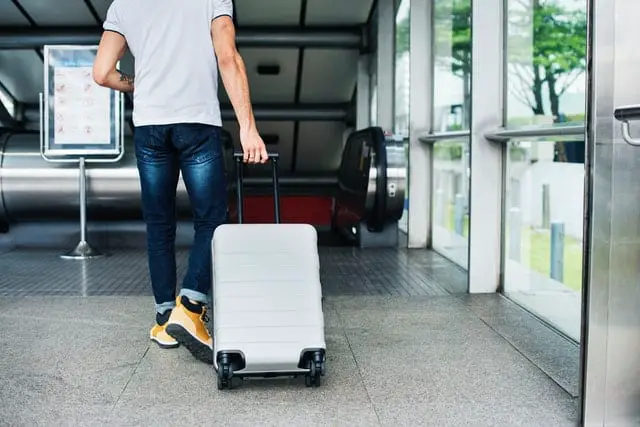If you have a long bus trip ahead of you, being able to get some sleep on board is likely important. Buses usually aren’t the most comfortable form of transportation and it can be difficult to sleep or sleep well.
Many of you might be thinking whether or not it’s even possible to get decent sleep on a crowded and moving bus. Well, the answer is yes. It’s possible for some. With careful planning and a few extra sleeping aids, you’ll be able to improve your quality of sleep on those long bus rides. Read on to see what steps you can take.

The Basics to Sleeping on a Bus
There are a number of things you can try to set yourself up with to be able to sleep on a bus. Essentially, you want to create your own little oasis of comfort within the confines of your seat – and a few simple things can help you achieve that.
We’ve found that following these eight easy steps can help you make the most of what is generally a pretty uncomfortable sleeping situation.
Use earplugs
Removing sound and blocking out distractions is key to getting sleep and staying asleep. There are lots of choices for earplugs – some of which offer full noise cancellation. A trip to your local drug store will present you with a multitude of choices. Pick a couple and try them out first at home to see which work best for you and which you are most able to tolerate. Better yet, if you have a snoring bedmate to test them on and you are successful in getting to sleep, you should be able to block out unwanted noise once on the bus.
Try a sleep mask
Yes, these can look a bit silly, but blocking out light will help you get better sleep. Besides, you’re unlikely to see the people on the bus with you again, so don’t be embarrassed; just give these a try. Pick one that has an adjustable strap so you can fit it to be most comfortable on your head. Amazon is a good place to find some fun ones.
You can even buy heated sleep masks and ones that utilize steam. These are supposed to help eye puffiness or dry eyes. If you go this route, pick one with a USB connection so you can plug it into the bus’s power system or your own power bank. Some come with earplugs and a carrying case so you can knock two of the other items off your list at the same time.
You can also get a sleep mask with built in speakers that connect to your smartphone via Bluetooth.
However, we’re not convinced the speakers on these sleep masks will be sufficient to block out annoying noises on the bus.
Bring a neck pillow
We think a neck pillow is an essential carry on to bring on a long bus ride. While seats on busses have improved, your neck is still going to be held at an unusual angle for an extended period of time – and you’re likely to end up with a stiff or painful neck as a result.
Memory foam neck pillows can be compressed down into a handy, small carry bags that don’t take up too much luggage space. They come in a variety of shapes, with the most typical being banana-shaped.
We don’t recommend blow up neck pillows. These don’t offer enough support and tend to lose air over time. You wake up with a flat pillow and a crick in your neck.
Some unusual neck pillows and foot rests
Inventors are constantly trying to come up with a better neck pillow and there are some interesting varieties on the market.
One we’ve found that we think looks promising is the infinity pillow. This can be wrapped around your neck or placed on the tray table in front of you (assuming you have one). Being able to change sleeping positions is something many people find conducive to getting a good sleep.
Another unusual neck pillow – known as the Travelrest – is strapped across your body and can be leaned into as you sleep. A bonus – you can also use this on a long car trip. And they are easy for children to use. If you are travelling with kids. If you’re someone who needs something to hug to get to sleep, this might be the pillow for you as it is very huggable.
Another option – the neck traction pillow – can be adjusted to your own particular desired firmness and wraps entirely around your neck. Being extremely customizable is one advantage of this type of neck pillow.
There are other neck pillows that are placed over your head, but aside from looking silly, we’re not convinced they provide enough support. They might be best for people who prefer to sleep leaning forward, either supported by your knees or a tray table.
Once your neck is taken care of, consider adding a portable footrest to your luggage. These come as sling-type rests that hang from your tray table or inflatable ones that are placed on the floor in front of your seat. Use of a foot rest can help alleviate some of the swelling you might get from prolonged sitting in the same place as well as help you get comfortable enough to sleep.
If you’re someone who suffers from leg swelling or you are at risk of having a deep vein thrombosis (DVT), a footrest is a necessity, along with a good pair of compression socks. Getting up and moving around every so often is also important in this case.
BYOB – Bring your own blanket
Consider bringing some of the comforts of home along with you on your bus ride. Packing a small blanket could help you sleep by mimicking the sensation of your own bed. Travel blankets are available that fold down into an easily packed dimension.
If you’re traveling with children, having their own, familiar blanket could help you navigate bedtime with less stress. Bring their favourite books and try to emulate their routine as much as possible.
Get into a routine
If you have a long journey, involving more than one night on a bus, establishing a routine that’s close to the bedtime routine you follow at home is important for adults as well, and will help you get to sleep and stay asleep. If you always read a bit before going to sleep, stick with that routine on your bus trip.
Avoid caffeine
This isn’t the time to be drinking an espresso, coffee or soft drink. Keeping hydrated with good old water is important on any long trip – whether by train, plane or bus. Bringing water from home or drinking bottled water is best for your digestive system.
Listen to music or white noise and use noise-cancelling earbuds
If earplugs aren’t enough to drown out the sounds of the bus and other travellers, playing a favourite playlist or relaxing white noise through your earbuds or headphones will help create a defense between you and the rest of the world. Many earbuds also have noise-cancelling capabilities.
We also recommend meditation or relaxation apps like Calm or Headspace. These apps guide you through a meditation exercise intended to provide relaxation. Listening to one of these meditation exercises takes you out of your own space on the bus and into a more comfortable location – at least in your mind.
Try red-lensed glasses
If you’re bothered by the blue lights on the bus and in the environment around the bus, red-lensed glasses can help lessen this impact. These glasses mimic natural light and help to regulate your circadian rhythms, leading to your body feeling ready for bed. They also block the amount of light reaching the eyes – tricking your brain into thinking it’s bedtime. By the time you slip on your eye mask and put in your ear plugs, you’ll be ready to fall asleep.
Natural Sleep Remedies

Melatonin
This hormone regulates our natural sleep/wake cycle and can be taken to help promote sleep. It should be taken for a few days before your trip to build up efficacy.
But a warning; melatonin can leave some people lethargic and sleepy the following morning. So, if you are travelling to a job interview or just generally need your wits about you when you arrive at your destination, this might not be the best choice.
St. John’s Wort
Not strictly a sleep aid, the extract from this weed is said to help ease depression and anxiety. If you’re an anxious traveller, taking St. John’s Wort may help you get to sleep. Just avoid sunlight – it can make you more sensitive to UV.
Chamomile Tea
Chamomile helps to promote relaxation, which may lead to a better sleep. As a plus, it can be taken as a tea and is readily available. Fill up your thermos with some chamomile tea and you’re good to go.
This article is owned by Sleeping Report and was first published on August 7, 2019
Valarian, Kava and California Poppy
Studies have shown that people who take valerian tend to doze off more quickly and stay asleep longer. Kava is said to also help with insomnia. Like St. John’s Wort, valerian, kava and California poppy promote relaxation and ease anxiety.
Passion flower
Passion flower contains a mild sedative and is, therefore, a good choice as an aid to sleep. It can be steeped and made into a tea.
Medicinal herb
Canada is one of only two countries – the other being Uruguay – to legalize the recreational use of a popular kind of medicinal herb, which I think we all know what I’m talking about. That said, most provinces and even municipalities have instituted laws regarding how and where this herb can be consumed. If you chose to use this medicinal herb to help you sleep, taking it in capsule form is likely not going to get you into trouble, while lighting one up might. Check with the rules where you’re travelling before picking this as your sleep aid.
The Not-So-Natural Aids to Sleep

If natural remedies don’t help, you may need to resort to taking sleeping pills. Always visit your doctor to determine which pills are best for you and how to take them.
Sleeping pills
Things to consider are how long you need to be on the medication for it to be effective and how long the side effects last. Like melatonin, if the sleeping pills are going to leave you sluggish and drowsy once you wake, they might not be right for you.
Additionally, sleeping pills can be addictive – something to definitely discuss with your doctor. Our choice is always to go the natural route if possible.
Careful Planning Will Improve the Experience

Treat a long bus trip like you would treat a long airplane flight and prepare for your journey before setting off. Make sure you’ve packed all the chargers you need for your electronic devices, your earbuds, sleep mask and ear plugs. Download a movie or two from Netflix or Amazon Video and you’ll keep yourself entertained until it’s time to go to sleep.
Book a first class seat if possible
Not all bus lines offer first class seats – but if the line you’re travelling with does, grab it. Well worth the extra cost for the extra space and comfort you’ll have.
Choose your seat carefully
You want to pick a seat that will ensure you have as comfortable and drama-free trip as possible. Experts say the middle of the bus is best – less bumpy ride, far enough from the bathrooms and the safest place to be if there is a collision.
If you’re a woman, you might want to specify that you want to sit next to another woman if you’re concerned about safety. You likely have your own preference regarding whether you want a window or aisle seat. We find a window seat best as it allows for a variety of places to lean your neck pillow; but some people prefer an aisle because they can stretch out and they won’t disrupt their row mate if they have to get up.
Look at how often the bus will stop
The milk run – everyone’s nightmare. Try to pick a bus that doesn’t stop at every town or city along the route. You’ll get to your destination more quickly and with less chance of being awoken by constant stops.
Park your carry on as if you were flying
Since your suitcase will likely end up under the bus in storage, make sure you’ve packed everything you’ll need for the journey in your carry on. Packing like you’re going on an airplane is a good routine to get into. Pack your medication, all your entertainment devices, your sleep mask, ear plugs and neck pillow and footrest in this bag.
Security can be an issue on a bus, so consider carefully where to put your valuables. Though not the most comfortable, consider a money belt. It is also possible to buy luggage and carry on bags with built-in safety features.
The Travelon brand, for instance, has bags with RFID blocking to protect your credit cards from being skimmed, lockable zippers and cut-resistant fabrics. We like this brand a lot. The bonus is that they function equally well if you are playing tourist and sightseeing. Many have a place to put a bottle of water and all keep your important items organized and safe.
Drink an energy drink
Believe it or not, drinking an energy drink will both keep you hydrated and limit how often you need to use a restroom. Pick something – like Gatorade – that replaces your electrolytes.
This article is owned by Sleeping Report and was first published on August 7, 2019
Let’s face it; no one really wants to use the toilet on a bus, and the facilities at rest stops are sometimes just as bad. Drink the energy drink early enough in your journey that it won’t keep you awake when it’s time to go to sleep, of course.
Bring your own snacks
Pack a variety of items to keep you from getting unnecessarily “hangry”. You’ll enjoy the trip more and save money if you bring your own snacks rather than waiting to buy them at rest stops. We like nuts and dried fruit, granola bars – anything that’s easily packable.
Plan Ahead and Arrive Ready to Go

Whatever the reason you have for travelling by bus, you can make the experience a good one and arrive at your destination refreshed and ready to do.
Is it possible to sleep comfortably on a bus? It is as long as you follow at least some of the steps we’ve outlined above and plan ahead. While a long bus journey may sound arduous, it is possible to turn it into a positive experience.
The top 10 things we’d most recommend you ensure are in your carry on are:
SleepingReport.com copyright article was updated on ..
- Ear plugs
- Sleep mask
- Neck pillow
- Blanket
- Noise-cancelling earbuds or headphones
- Snacks
- Entertainment devices – tablet or smartphone with movies and/or music
- Energy drink
- Sleeping aid – natural or sleeping pills
- Money belt or theft-deterrent bag for your valuable
Let me know what you think about this article?

